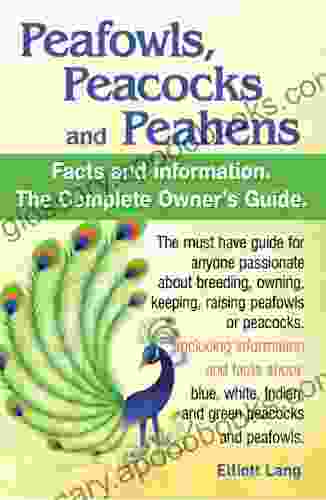Peafowls, Peacocks, and Peahens: A Comprehensive Guide

Peafowls, with their stunning iridescent plumage and flamboyant courtship displays, are captivating birds that have captured the imagination of humans for centuries. This article will delve into the fascinating world of peafowls, exploring their unique characteristics, behavior, and captivating beauty.
Identifying Peafowls, Peacocks, and Peahens
Peafowls, peacocks, and peahens are all members of the pheasant family (Phasianidae). Peafowls are characterized by their large size, with males (peacocks) typically weighing around 9-13 pounds (4-6 kilograms) and females (peahens) weighing around 6-9 pounds (3-4 kilograms).
4.3 out of 5
| Language | : | English |
| File size | : | 1091 KB |
| Text-to-Speech | : | Enabled |
| Screen Reader | : | Supported |
| Enhanced typesetting | : | Enabled |
| Print length | : | 95 pages |
| Lending | : | Enabled |
Peacocks are renowned for their spectacular train, an elaborate display of elongated tail feathers that can reach up to 6 feet (1.8 meters) in length. Female peahens are less ornate, with shorter tails and duller plumage.
Distribution and Habitat
Peafowls are native to South Asia, where they inhabit forests, scrublands, and grasslands. They have been introduced to many other parts of the world, including Europe, North America, and Australia, where they have adapted to various habitats, including parks, gardens, and urban environments.
Behavior and Diet
Peafowls are social birds that live in flocks. They are predominantly omnivorous, feeding on a variety of plants, insects, small reptiles, and amphibians. Their diet includes fruits, seeds, leaves, and roots, which they forage on the ground.
During the breeding season, male peacocks engage in elaborate courtship displays to attract females. They fan their trains into a magnificent display, vibrating their feathers to create a captivating sound. Females are attracted to the most flamboyant and healthy-looking males.
Reproduction
Peafowls typically reach sexual maturity at around 2-3 years of age. They breed during the spring and summer months. Females lay clutches of 4-8 eggs in nests on the ground. The eggs are incubated for about 28-30 days before hatching.
Chicks, known as peachicks, are precocial, meaning they are born with their eyes open and are able to walk and feed themselves almost immediately. They are cared for by both parents until they become independent at around 6-9 months.
Varieties of Peafowls
There are three recognized species of peafowl:
* Indian Peafowl (Pavo cristatus): The most common species, known for its vibrant blue and green plumage. * Green Peafowl (Pavo muticus): Native to Southeast Asia, characterized by its emerald-green plumage and black mask. * Congo Peafowl (Afropavo congensis): Endemic to the Congo Basin, with a distinctive blue-purple plumage and crest.
Conservation Status
The Green Peafowl and Congo Peafowl are listed as endangered and critically endangered, respectively, by the International Union for Conservation of Nature (IUCN). Habitat loss, illegal hunting, and hybridization with the Indian Peafowl pose significant threats to their populations.
Peafowls in Culture
Peafowls have been revered and admired throughout history for their beauty and symbolism. In ancient Greece, peacocks were associated with the goddess Hera, while in Hinduism, they are considered the sacred bird of the god Kartikeya.
In many cultures, peacocks are seen as symbols of beauty, vanity, and royalty. They have been depicted in art, literature, and textiles for centuries, captivating people with their stunning appearance and captivating displays.
Peafowls, peacocks, and peahens are extraordinary birds that have captivated humans for centuries. Their vibrant plumage, elaborate courtship displays, and symbolic significance have made them enduring objects of fascination and admiration.
By understanding the unique characteristics and behavior of peafowls, we can appreciate their remarkable beauty and ensure their continued survival for generations to come.
Call to Action
If you are captivated by the enchanting world of peafowls, delve deeper into their fascinating stories. Visit local zoos, wildlife sanctuaries, or ornithological centers where you can witness their magnificent presence firsthand.
Learn more about peafowls and their vital role in our natural heritage by exploring the following resources:
* World Pheasant Association * Peafowl Conservation Foundation * International Union for Conservation of Nature
By fostering a greater understanding and appreciation for peafowls, we can help protect these remarkable birds and ensure their continued existence for generations to come.
4.3 out of 5
| Language | : | English |
| File size | : | 1091 KB |
| Text-to-Speech | : | Enabled |
| Screen Reader | : | Supported |
| Enhanced typesetting | : | Enabled |
| Print length | : | 95 pages |
| Lending | : | Enabled |
Do you want to contribute by writing guest posts on this blog?
Please contact us and send us a resume of previous articles that you have written.
 Book
Book Novel
Novel Page
Page Chapter
Chapter Text
Text Story
Story Genre
Genre Reader
Reader Library
Library Paperback
Paperback E-book
E-book Magazine
Magazine Newspaper
Newspaper Paragraph
Paragraph Sentence
Sentence Bookmark
Bookmark Shelf
Shelf Glossary
Glossary Bibliography
Bibliography Foreword
Foreword Preface
Preface Synopsis
Synopsis Annotation
Annotation Footnote
Footnote Manuscript
Manuscript Scroll
Scroll Codex
Codex Tome
Tome Bestseller
Bestseller Classics
Classics Library card
Library card Narrative
Narrative Biography
Biography Autobiography
Autobiography Memoir
Memoir Reference
Reference Encyclopedia
Encyclopedia Thomas W Hill
Thomas W Hill William Cope Moyers
William Cope Moyers Julie Shackman
Julie Shackman Phoebe Wang
Phoebe Wang Emily Fincher
Emily Fincher Jc Anonymous
Jc Anonymous Marie Kristin Hofmann
Marie Kristin Hofmann Nilo W Hovey
Nilo W Hovey Dennis Prager
Dennis Prager Derek Cabrera
Derek Cabrera Ralph Dolgoff
Ralph Dolgoff Kristin M Roach
Kristin M Roach Laura Wasilowski
Laura Wasilowski Enda Walsh
Enda Walsh Diane Wald
Diane Wald Dennis Drabelle
Dennis Drabelle Lilac Mills
Lilac Mills Sara Hazel
Sara Hazel Mary Kendall
Mary Kendall Jaroslav Kalfar
Jaroslav Kalfar
Light bulbAdvertise smarter! Our strategic ad space ensures maximum exposure. Reserve your spot today!

 Roger TurnerDiscover the Comprehensive Guide to Abdominoplasty: Enhance Your Body Contour...
Roger TurnerDiscover the Comprehensive Guide to Abdominoplasty: Enhance Your Body Contour...
 Brennan BlairUnlock Your True Self: Overcoming Emotional Overeating with EFT Emotional...
Brennan BlairUnlock Your True Self: Overcoming Emotional Overeating with EFT Emotional... Vernon BlairFollow ·16k
Vernon BlairFollow ·16k Barry BryantFollow ·8.5k
Barry BryantFollow ·8.5k Sidney CoxFollow ·2.7k
Sidney CoxFollow ·2.7k Ruben CoxFollow ·8.2k
Ruben CoxFollow ·8.2k Ivan TurnerFollow ·15.5k
Ivan TurnerFollow ·15.5k Colin FosterFollow ·19.1k
Colin FosterFollow ·19.1k Kenneth ParkerFollow ·17k
Kenneth ParkerFollow ·17k Garrett BellFollow ·11.2k
Garrett BellFollow ·11.2k

 Clarence Mitchell
Clarence MitchellCollection Of Handcrafted Plants For The Blackest Of...
Do you have a black...

 Edgar Hayes
Edgar HayesClassic Racing Mystery From The King Of Crime
Agatha Christie, the...

 Demetrius Carter
Demetrius CarterLafayette: Courtier to Crown Fugitive, 1757-1777
The Marquis de...

 Jared Powell
Jared Powell30 Gorgeous Sweaters, Cardigans, Hats, Toys & More:...
Immerse Yourself...
4.3 out of 5
| Language | : | English |
| File size | : | 1091 KB |
| Text-to-Speech | : | Enabled |
| Screen Reader | : | Supported |
| Enhanced typesetting | : | Enabled |
| Print length | : | 95 pages |
| Lending | : | Enabled |












